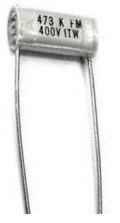Types of Capacitors
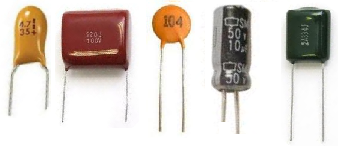
There are many different types of capacitors and they each vary in their characteristics and each have their own advantages and disadvantages.
Some types of capacitors can charge up to higher voltages and, thus, can be used in high voltage applications. Some capacitors can charge up to very high charges, such as aluminum electrolytic capacitors. Some capacitors have very low leakage rates and others have very high leakage rates. All of these factors determine how and in what application each of the capacitors will be used in circuits.
Below is a list of the various types of capacitors, as we go over the characteristics that make them up:
Aluminum Electrolytic Capacitors
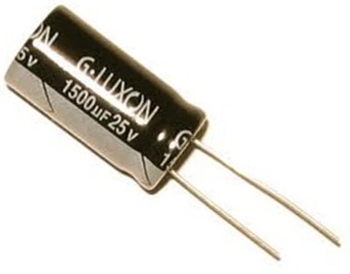
Aluminum Capacitors are capacitors that are composed of two rolled up strips of aluminum foil with a strip of absorbent paper between them which is soaked in an electrolyte solution- all this being sealed in a can.
Aluminum electrolytic capacitors cover the capacitance range of 0.1µF to 500,000µF, making them one of the
largest
capacitors in terms of capacitance storage. This is one of their main advantages, that they store such
a high value of charge. Working voltages range from 10V to 100V. The disadvantages of aluminum electrolytic
capacitors is that they have high leakage rates, so they tend to leak out a lot of DC current,
which makes them bad in applications for
high-frequency AC coupling. They also have
a wide tolerance range, usually ±20% or more. This makes them poor in applications where precise values
are needed, such as in timing or filtering circuits. Thus, they generally are not used in these applications.
Tantalum Capacitors

Tantalum Capacitors are capacitors that are made of tantalum pentoxide.
Tantalum capacitors, just like aluminum, are electrolytic capacitors, which means they are polarized.
Their main advantages (especially over aluminum capacitors) is that they are smaller, lighter, and more stable. They have lower leakage rates
and less inductance between leads. However, their disadvantages are they have a lower maximum capacitance storage and lower maximum working voltage.
They are also more prone to damage from high current spikes. For the last reason, tantalum capacitors are used mostly in analog signal systems that
lack high current-spike
noise.
Ceramic Capacitors

Ceramic capacitors are capacitors that are composed of materials such as titanium acid barium as its dielectric. Together with electrolytics, they are the most widely used capacitors around.
Ceramic capacitors have high capacitance values for their size. They are made in the range of 1pF up to several microfarads (µF), but do not have the very high capacitance values as electrolytic capacitors. They are manufactured with a wide range of working voltages and tolerance values. One main advantage of ceramic capacitors are, internally, they are not constructed as a coil, so they have low inductance and, thus, are well suited for higher-frequency applications. They are widely used for many purposes, including decoupling.
A NPO ceramic capacitor is one which is an ultrastable or temperature-compensating capacitor.
It is one of the most highly stable capacitors. It has very predictable temperature coefficients (TCs) and, in general, does not age with time.
Being so, it is highly
suitable for tuning circuits and filter applications.
Polyester Capacitors

Polyester capacitors are capacitors composed of metal plates with polyester film between them, or a metallised film is deposited on the insulator.
Polyester capacitors are available in the range of 1nF to 15µF, and with working voltages from 50V to 1500V.
They come with the tolerance ranges of 5%, 10%, and 20%. They have a high temperature coefficient.
They have high isolation resistance, so they are good choice capacitors for coupling and/or storage applications.
Compared with most other types, polyester capacitors have high capacitance per unit volume. This means more capacitance can
fit into a physically smaller capacitor. This feature, together with their relatively low price, makes polyester capacitors a widely used,
popular, and cheap
capacitor.
Polypropylene Capacitors
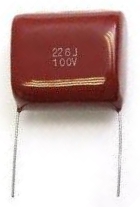
Polypropylene capacitors are capacitors that have a dielectric that is made of polypropylene film.
Polypropylene capacitors cover the value range of 100pf to 10µF. One of their main and key features is their high working voltage. Polypropylene types with working voltages up to 3000V are made. These features make polypropylene capacitors useful in circuits in which operating voltages are typically high. These include power supply circuits, power amplifiers, particularly valve amplifiers and TV circuits. Another great advantage of polypropylene capacitors are their great tolerance values. Tolerance is about 1 percent, so it's pretty precisely near their nominal values. Polypropylene capacitors are used when a better tolerance is needed than what a polyester capacitor can provide. Polypropylene capacitors also have high isolation resistance, which makes them a good choice for coupling and/or storage applications. They exhibit stable capacitance for frequencies below 100KHz.
These capacitors are used for noise suppression, blocking, bypassing,
coupling, filtering, timing, and handling pulses.
Polystyrene Capacitors

Polystyrene capacitors are capacitors that have a dielectric made up of polystyrene.
They come only in low values, usually 10pF to 47nF. Normally, their tolerance is 5% to 10% but high precision polystyrene capacitors are also available with tolerances of 1% and 2%. Working voltages for polystyrene capacitors are 30V to 630V. Polystyrene capacitors are advantageous in that they have high isolation resistance, so they are good for use in coupling and storage applications. The precision types are suitable for timing, tuning and filter circuits.
One of their disadvantages are they are constructed like a coil inside, so they are not suitable for high-frequency applications. (This is because
coils create inductance, and inductance blocks
high-frequency signals from passing through.) Another disadvantage is that polystyrene capacitors exhibit a permanent change in value should they ever be exposed
to temperatures much
over 70°C; they do not return to their old value upon cooling.
Polycarbonate Capacitors

Polycarbonate capacitors are capacitors that have a polycarbonate dielectric.
They come in the capacitance value range of 100pF to 10µF, and have working voltages up to 400V DC.
They're advantageous in the area that they have fairly good temperature coefficients, so they don't vary much with
changes in temperature. This makes them preferred to polyester capacitors.
They are disadvantageous in that they have fairly high tolerance levels, 5% and 10%, making them not so great for high-precision applications.
Silver Mica Capacitors
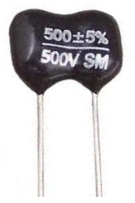
Silver Mica Capacitors are capacitors that are made from depositing a thin layer of silver on a mica dielectric.
Silver Mica Capacitors are very stable with respect to time. They are advantageous in that they have tolerances of 1 percent or less. They also have a good temperature coefficient and excellent endurance. However, they don't come in high capacitance values and can be expensive.
Silver mica capacitors are used in resonance circuits and high-frequency filters, due to good stability with temperature.
They are also used in high-voltage circuits, because of their good insulation.
Paper capacitors are capacitors that are made of flat thin strips of metal foil conductors separated by a dielectric of waxed paper.
They have a capacitance range of 500pF to 50µF and a high working voltage, so, thus, they are used mainly in high-voltage equipment.
The downside of paper capcitors are that they have high leakage rates, making them unsuitable for AC coupling, and their tolerances are no better than
10% to 20%,
making them unsuitable for precision timing circuits.
These are many of the different types of capacitors. This isn't an exhaustive but the main types are all covered here.

